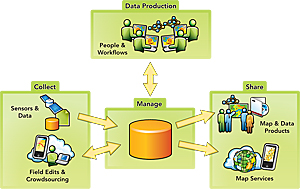Making More and Better Maps and Charts Faster

Commercial GIS has evolved to help mapping and charting organizations efficiently manage, validate, and incorporate the increased variety and volume of information available. By putting focus and emphasis on managing the data content, these organizations are able to generate multiple outputs from a single source and achieve significant efficiency and quality improvements over traditional "stovepipe" production lines.
GIS is entering a new modality where advances in technology, measurement, software, science, and open data policies are creating a universal geospatial infrastructure. The proliferation of online geospatial information coming from both official and volunteered sources makes the jobs of authoritative content producers at mapping and charting organizations more critical. These organizations make up the core of the geospatial infrastructure, creating the foundational spatial information for GIS systems. They have the responsibility of providing the quality, accurate geospatial data and maps or charts that other organizations—and sometimes even lives—depend on.
In this fast-paced online, on-demand environment, the primary challenges faced by mapping and charting organizations are time, resources, and a difficult economic climate—the conundrum epitomized by the phrase "good, fast, and cost-effective—pick two." For authoritative content producers, ignoring "good" is not an option, so they are caught between the seemingly opposing choices of producing data, maps, and charts quickly or doing so cost-effectively.
This challenge applies regardless of the size of the organization. While in many countries, mapping and charting organization is synonymous with national mapping agency, any group responsible for producing geospatial data, maps, and charts with exacting quality and output requirements faces the same challenge, whether it's a commercial entity; city, county, or state department; small GIS consultancy shop; or outsource contractor. All must produce more and better maps or charts faster than in the past while incorporating more sources and types of information (including volunteered geographic information, or VGI).
As demonstrated in the articles presented in this mapping and charting special section, mapping and charting organizations rely on GIS to help them, leveraging geodatabase technology to support the workflow of collecting, managing, producing, and exploiting data. Commercial GIS has evolved to further support these organizations and allow them to achieve both fast and cost-effective production. The ArcGIS system and ArcGIS software-based commercial off-the-shelf solutions have been designed to optimize production processes, orchestrating an organization's GIS to support standardization, efficiency, and repeatability. They support a collaborative shared work environment to ensure that teams follow the same rules whether sitting in the same room or across the world from each other. This means that organizations working with contractors can impose the same workflows, quality rules, and production standards on those contractors as used inside the organization. It also means that even the smallest departments can collaborate effectively with their stakeholders or contractors in such a way as to operate like a much larger one.
ArcGIS offers solutions for topographic, aeronautical, and nautical organizations, supporting industry-specific standards for those organizations. ArcGIS also provides extensions for managing GIS workflows or automating the data quality process. All are easily configurable for organization-specific standards and help mapping and charting organizations achieve economies of scale by better managing, validating, and incorporating the increased variety and volume of information available. By putting focus and emphasis on managing the data content, mapping and charting organizations are able to generate multiple outputs from a single source and achieve significant efficiency and quality improvements over traditional "stovepipe" production lines.
The geospatial world is moving increasingly toward an open geospatial infrastructure that connects producers and users of authoritative source datasets via the web. Commercial GIS is evolving to support mapping and charting organizations in their missions and in their participation in this new world by enabling them to improve the speed and accuracy of their data, maps, and charts without increasing resources—good, fast, and cost-effective.
For more information, visit esri.com/map-chart-dataproduction.
Related Podcast
From Hard Copy to JavaScript: The Atlas of New South Wales
Stephen Lead, principal GIS consultant at Ajilon, discusses the design inspirations behind the Atlas of New South Wales. Listen to the podcast. [09:00 | 9 MB]